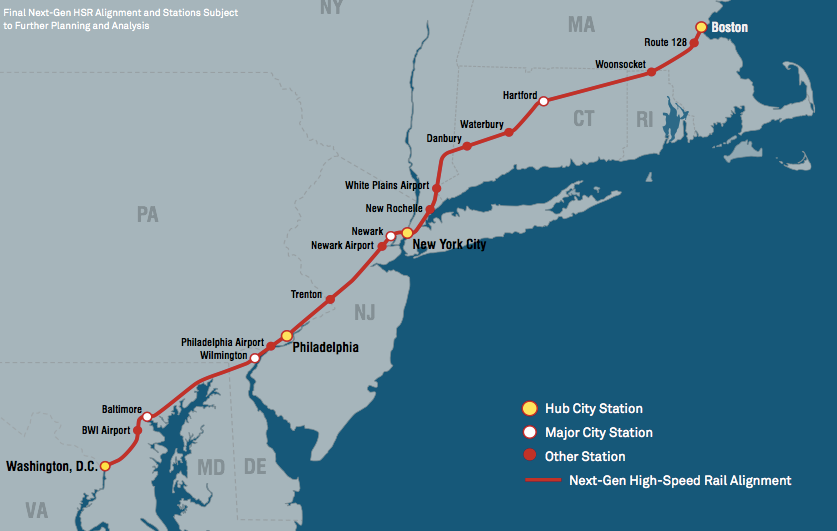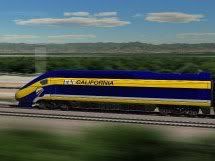(2 pm. – promoted by ek hornbeck)
Burning the Midnight Oil for Living Energy Independence
 The headline spin on House Chairman of the Transport Committee is that he is proposing to privatize the NEC to allow HSR to be built in this decade.
The headline spin on House Chairman of the Transport Committee is that he is proposing to privatize the NEC to allow HSR to be built in this decade.
However, if you follow the money trail, while he proposes a process to do that, there is no funding proposed to do that. And without a funding stream for the federal share of anywhere from $40b to $100b to bring the NEC up to a state of good repair and then to make the improvements required, under current FRA regulations, to meet Mica’s modest speed targets … that part of it is not a real proposal yet.
The real proposal is to have talking points to use to object to any funding that gets out of the Senate to allow Amtrak to buy more equipment so it can expand the capacity and frequency to meet the steady increase in demand for its services.
Amtrak vs Mica
 Last year, Amtrak set forward its NextGen proposal for a Ltd Stops Express HSR from DC to NYC to Boston in 3:23 (all stops 4:03).
Last year, Amtrak set forward its NextGen proposal for a Ltd Stops Express HSR from DC to NYC to Boston in 3:23 (all stops 4:03).
Representative Mica proposed DC to NYC in 2:00 and NYC to Boston in 2:30, under a framework in which no project is graded up for achieving better times than that, so it can be taken as DC/Boston in 4:30, an hour slower than the NextGen.
The Amtrak NextGen has been criticized (in my personal opinion, with substantial reason) for being overengineered. Its headline price is $117b, which Mica uses to great effect. Of course, Mica knows that describing it as a $117b project is deceptive, since these are year of expenditure dollars for a project that is slated to be rolled out in two phases, one 2020-2030, and the next 2030-2040. Assuming a 2030 midpoint and 3% GDP inflation, $117b over 2020 to 2030 is about $65b in 2010 dollars.
This is on top of the Amtrak program to bring the NEC up to a state of good repair combined with needed upgrades to the NEC itself, which the private bidder for the NEC would be required to do.
How much does Mica’s project cost? He punts the price tag. All that the proposal says is that the private bidders will set forth their strategy for meeting the requirements, and how much public capital subsidy will be required, and that’s it. Say the winning bid is to upgrade the NEC to something between a Regional HSR system and the California HSR 220mph Express HSR system sets the public capital grant at $50b … where does the $50b come from?
That’s the beauty of Mica’s proposal as a source of talking points: there’s no price tag to be attached for his underwhelming speed goals. Its just “the private bid that best meets the requirements while requiring the least money”. The reactionary echo chamber is free to imagine a ridiculously low amount of public capital spending, to imagine a massive benefit/cost ratio … because its just “we’ll find out where the many $10b’s will come from when the time comes”.
Odds are that it’ll be cheaper than the combined Amtrak NEC Master Plan and Amtrak NextGen, because instead of upgrading the NEC and building a new Express HSR alignment, the proposal is to upgrade the NEC into a not-very Express HSR alignment, with all the details to be worked out by the bidding consortiums.
If its not a real Express HSR Proposal, What Is It Really?
What this is “really” is an effort to divide and conquer the political coalition behind Amtrak. That is a political tripod:
- The Northeast, where replacing Amtrak intercity services would cost many $10b’s in roadwork and airport expansion in the most expansive part of the country for airport and road expansion
- Rural communities dependent on Amtrak for regular intercity service into metropolitan areas, as they are too small and too far from a major metropolitan area for effective air service.
- Those states that have increasingly effective state-subsidized regional corridor services, including California, Washington and Oregon, Illinois, Virginia and North Carolina.
At present, the Regional HSR Amtrak Acela service generates an operating surplus, and that operating surplus reduces the operating subsidy required by Amtrak to provide long haul passenger service, with regional corridor service primarily funded by state level rather than federal subsidy.
Under Mica’s proposal, all of the state corridors will be required to put service out to tender, with the winning bid having to involve less federal subsidy than under Amtrak. The long haul routes that are intrinsically subsidized public utility services when operated at conventional rail speeds will be subject to privatization if a private operator submits an expression of interest ~ and again, the winning bid will have to be at less than the Amtrak level of subsidy.
Privatize the NEC, and the political tripod is broken:
- There is no longer a community of interest between rural communities dependent on subsidized intercity service and the heavily urbanized Northeast Corridor, since the increased operating surpluses generated by the privatized NEC will have been divided between capital improvements and operator profits.
- Long Haul and Regional routes that run into the NEC will no longer have the right to do so, which means that the North Carolina and Virginia corridors, as well as the Cardinal, terminate at DC, and the Pennsylvanian terminates at Harrisburg, to transfer to a private rail operator at prices set by the private rail operators.
- The authority of Amtrak to operate routes under its original founding agreement in which freight railroads were relieved of passenger rail service requirements will be replaced by “market negotiations” with Right of Way owners.
So that is the ambition of the proposal: break up the political coalition supporting Amtrak, and leave the Northeast, the states with regional corridors, and the rural communities dependent on long haul Amtrak routes to each fend for themselves in chasing individual capital or operating subsidies to meet their intercity transport needs.
But assuming that the Senate will not jump to break up Amtrak, there ought to be an immediate political ambition to the proposal as well. And that immediate political ambition is to use absurdly optimistic characterizations of what the bill will achieve as part of running interference against efforts to improve Amtrak service.
The Need to Block Purchase of New Rolling Stock
Amtrak’s biggest problem is the crippling lack of new equipment.
It can’t come up with locomotives and coaches to make up a train for any new state-supported corridor.
It can’t add coaches to its own heritage short-distance trains, mostly in the Empire Corridor, NYC-Albany-Buffalo and the Wolverines, Chicago-Detroit.
It can’t run a daily Cardinal, NYC-D.C.-Charlottesville, VA-Charleston, WV-Cincinnati-Indianapolis-Chicago, much less a daily Sunset Limited, New Orleans-Houston-San Antonio-Tucson-almost Phoenix-L.A. It simply does not have equipment for the needed trains. So these three-times-a-week trains lag far behind the returns on the other, daily l.d. trains. The Cardinal and the Sunset thereby provide the cultist critics with the “big-money-losing, high-subdidy-needing” examples to make their case that Amtrak is a loser. The haters certainly don’t want those two l.d. trains to get improved.
It can’t add another l.d. train Chicago-East Coast that would visit Toledo (bus to Detroit)-Cleveland-Buffalo during daylight hours, or link thru Chicago-Toledo/Detroit-Cleveland to the Pennsylvanian’s Pittsburgh-Harrisburg-Philly cities.
It can’t extend more Regional trains down to Norfolk or Roanoke or Raleigh or Charlotte, or up from NYC to Albany or Syracuse or Hartford-Springfield-Worchester-Boston North Station-Portland.
Meanwhile, the current fleet is reaching the end of its normal life cycle, with increasing problems occurring while in service and increasing maintenance costs.
Amtrak has proposed a very large order of new-and-improved equipment. The railcars would still be FDA-heavy, but at least would offer larger windows, better toilet facilities, electric outlets at every seat, Wi-Fi capability, nicer seats – lots of stuff customers would like. Amtrak asked Congress to authorize a purchase of over 1,000 new coaches, sleepers, diners, lounges, baggage cars, crew dorms, whathaveyou, oh, locomotives it likes to describe as ‘faster-accelerating.’ That request is pending.
But instead of dealing with the real business needs of Amtrak, Congress will instead provide a circus’ worth of diversions about “privatizing” and “spinning off” and doing this or that or the nothing. Mostly the nothing. Nothing will be done about Amtrak’s need for new equipment or any of its other real world problems.
That’s what is really going on here: economic sabotage for political objectives, the real world consequences be damned.
What Can Be Done?
So, we have this fake proposal to establish HSR in the NEC through the magic of privatization with public subsidy with no upper bound on the amount of public subsidy required. Aimed at blocking any funding of substantial new rolling stock at the very least, and at shattering the coalition of interest supporting the various services provided by Amtrak at its most ambitious.
The shell game that will follow is obvious: after taking the NEC from Amtrak, and putting HSR out to bid, it will be found that all the bids cost too much, so we won’t even get the 4:30 Boston/DC promised in the bill. Except now Amtrak is a provisional operator, and has neither authority nor incentive to pursue capital improvements on the NEC.
The thing is, because Mica’s proposal is not a serious effort to actually achieve Express HSR in the Northeast Corridor, it leaves itself open to a messaging counter-offensive.
It costs too damned much: We know it costs too damned much because it does not tackle regulatory reform. If the NEC could adopt standards of the international railway industry organization, the UIC, it could run lighter weight trains which would accelerate faster and use less power, with greater allowed banking of express track and substantially greater allowed speed through turns for tilt trains, run with shorter turn-arounds, and could get more passenger benefit from the same capital subsidy.
 It goes too damned slow: 4:30? Really? That’s an hour slower than best international commercial transit speeds. Why aim for no more than the international semi-finals? Since when did the US become so pathetic that we could no longer aim to be among the best?
It goes too damned slow: 4:30? Really? That’s an hour slower than best international commercial transit speeds. Why aim for no more than the international semi-finals? Since when did the US become so pathetic that we could no longer aim to be among the best?
Its the wrong damned privatization: What we need to get to 3:30 in the DC/Boston run is a new alignment. Mica criticizes the NG proposal, but fails to provide a new alignment.
So what to do with Mica’s proposal? Amend it beyond all recognition into some useful, stealing as many of its positive talking points as possible while supporting talking points against the original proposal.
The Amended Mica Proposal
Steal the Privatized HSR Thunder: Take all of the US DOT taking over the NEC, Executive Committee to lease the NEC, private bidder language, strip out the NEC take-over, and replace it with a new corridor. Make the requirements a 5-stop DC to Boston service in 3:45 or less and 15+ stops DC to Boston service in 4:15 or less.
Note that this takes the Mica decision to punt the price tag and turns it on its head. Since the proposal is, “private bidders bid, we’ll see how much it costs”, there is no need to price the improvement of service. Its just Mica’s halfway to Express HSR times vs world class Express HSR times.
And since the NEC itself is no longer privatized, it offers this “private Express HSR” system without taking current NEC service away.
Adopt the Regulatory Reform Mantle: Whenever a Republican passes over the opportunity to propose regulatory reform, it seems worthwhile to look at what regulatory reform might have to offer. In this case, mandate that Amtrak in cooperation with the Department of Transport identify and report on the benefits of adoption of common international standards, individually and in combination, to cost, capacity and service speed of NEC services in six months.
 Extend the Cross-Subsidy Model for Regional HSR: The surpluses on the NEC cross-subsidize long haul services ~ but the NEC is far from the only corridor which can operate at transit speeds competitive with or faster than driving that could generate operating surpluses to cross-subsidize long-haul services. Mandate that Amtrak identify five regional corridors which if upgraded to Rapid Rail 110mph or better speeds and allocated to Amtrak could generate additional surpluses to cross-subsidize public utility long-haul and regional corridor passenger rail service.
Extend the Cross-Subsidy Model for Regional HSR: The surpluses on the NEC cross-subsidize long haul services ~ but the NEC is far from the only corridor which can operate at transit speeds competitive with or faster than driving that could generate operating surpluses to cross-subsidize long-haul services. Mandate that Amtrak identify five regional corridors which if upgraded to Rapid Rail 110mph or better speeds and allocated to Amtrak could generate additional surpluses to cross-subsidize public utility long-haul and regional corridor passenger rail service.
And Give Amtrak the Rolling Stock It Needs: All of the above are essentially zero ticket price items, to put the Mica proposal on the back foot while requiring difficult political gymnastics to campaign against. Here, a funding source is identified ~ say, removal of a redundant oil company production subsidy ~ to fund the acquisition of the required rolling stock by the Department of Transport, under the management of the Executive Committee set up for the NEC HSR project ~ and leased to Amtrak for its services.
Short Term and Long Term Objectives
In the short term, its unlikely that the rolling stock acquisition will get made. But its a slippery proposal to run against, especially in a Presidential year electorate. It doesn’t, after all, take a stand on whether Amtrak or some private rail operator will be using the rolling stock ~ it just ensures that the rolling stock is available to provide the services. A populist candidate in a more conservative district can, with a straight face, campaign for the use of oil company windfall profits to buy the rolling stock, and for opening up provision of the service “to competition”.
Its hard to tell what the prospects of the “low ticket price” items are. The regulatory “reporting” mandate does not deliver direct outcomes, but the reports lay the foundation for election year bills that may be hard to vote against or hard to campaign against. Voting against even finding out what savings are available from regulatory reform is a vote that some reactionary politicians just will not take, since it can be used to undermine their “deregulation” credentials.
The offer of the “public/private partnership” Express HSR corridor with the break-up of Amtrak stripped out means that all of the investment into talking up how much better a “PPP” approach is has to be either walked back, or directed into exactly what the dominant reactionary wing of the Republican party does not want, which is to get the ball rolling on a serious Express HSR corridor project in the NEC. So at the very least the political capital invested into that messaging is wasted, and at best it is diverted into a public good rather than a public bad.
But it is the corridor cross-subsidy that is the most politically insidious proposal, since it offers the prospect in more urbanized states of additional Federal capital funding combined with the prospect in more rural areas of subsidized intercity rail that does not require ongoing Congressional appropriation to maintain.
The best packaging of this counter-attack is therefore in two bills. The rolling stock acquisition for the DoT to be leased out to whatever operator is providing federally mandates intercity rail services goes into one bill, and the free-standing Next Generation Express HSR for the Northeast, regulatory reform mandate, and corridor cross-subsidy mandate is the amended version of whatever happens to Mica’s proposal in the House.
Midnight Oil ~ One Country
…
One country one
Country one countryWho wants to sit around
Turn it up, turn it down
Only a man can be
What his life can beOne vision
One people
One landmass
We are defenceless
We have a lifelineOne ocean
One policy
Seabed lies
One passion
One movement
One instant
One difference
One lifetime
One understanding

1 comments
Author
Of course, that’s why you don’t listen to the patter at the three card Monte table …